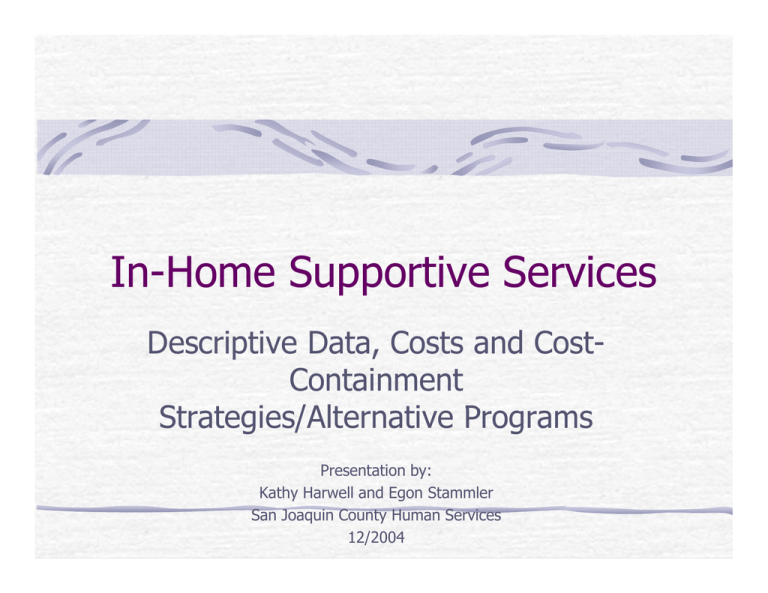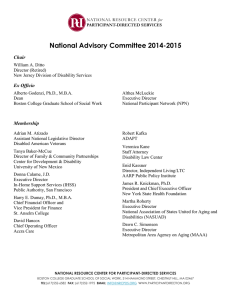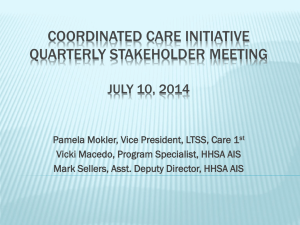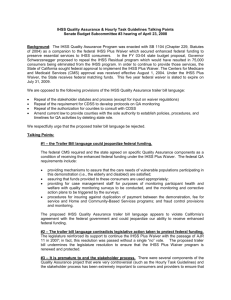I H S ti i
advertisement

I H In-Home S Supportive ti S Services i Descriptive D i ti Data, D t C Costs t and dC Costt Containment St t i /Alt Strategies/Alternative ti P Programs Presentation by: Kathy Harwell and Egon Stammler San Joaquin County Human Services 12/2004 Age of Recipients 0-17 yea 0 years s 4% 18-64 years 37% 65+ years 59% Ethnicity of Recipients Hispanic 22% White 44% American Indian 1% Black 17% Asian 16% Primary Language by Ethnicity 1% 100% 6% 90% 36% 80% 63% 70% 60% 85% 99% 50% 94% Non-English g English 40% 64% 30% 37% 20% 10% 15% 0% Asian Black Hispanic American Indian White Primary Language of Recipients Other 43% English 57% Other Languages Spoken by Recipients 45000 40000 35000 30000 25000 20000 15000 10000 5000 0 Spanish Armenian Russian Farsi Cantonese Vietnamese Tagalog Mandarin Cambodian Korean Hmong Consumer Type of Recipients Aged 47% Disabled 50% Blind 3% Change in Consumer Type from 1996 to 1998 60.0% 50 0% 50.0% 51.3% 5 3% 48.8% 47.5% 44.9% 40.0% 1996 1998 30.0% 20.0% 10.0% 3.7% 3.7% 0 0% 0.0% Aged Blind Disabled Distribution of County IHSS Cases by Program 100% 90% 80% 70% 60% 50% % Residual /Split 40% % PCSP 30% 20% 10% 0% Fresno Kern Kings Madera Mariposa Merced San Joaquin San Luis Obispo Santa Stanislaus Barbara Tulare Total IHSS Caseload byy Countyy 800000 700000 600000 500000 400000 300000 200000 100000 0 Fresno Kern Kings Madera Merced San Joaquin San Luis Obispo Santa Barbara Tulare Stanislaus Mariposa IHSS Cost Drivers From FY 1998-99 to 2002-03, IHSS program costs nearly doubled (from $1.4 billion in 1998 99 to $2.3 1998-99 $2 3 billion in 2002-03). 2002 03) Due to Realignment pressures, counties are being forced to transfer revenue (up to 10%) from the Mental Health Account and the Health Account to subsidize the Social Service A Account. t The overall cost per authorized case has increased 27% on a statewide level from FY 1996-97 to 98-99. Costs for Authorized Cases, FY 96/97 to FY 98/99 $1 400 000 000 $1,400,000,000 $1,200,000,000 $1,224,354,859 $1,000,000,000 $800,000,000 $879,469,434 $600,000,000 $400 000 000 $400,000,000 $200,000,000 $0 FY 96/97 FY 98/99 Percent Change in Average Monthly Cost Per Authorized Case from FY 96/97 to FY 98/99 40% 35% 37% 35% 33% 30% Statewide, 27% 28% 25% 26% 28% 28% 27% 22% 20% 17% 15% 15% 10% 5% 0% Fresno Kern Kings Madera Mariposa Merced San Joaquin San Luis Obispo Santa Barbara Stanislaus Tulare Cost-Related Concerns 1. Caseload growth/Overall population g growth 2. Provider wage increases/Addition of provider benefits 3. Lack of uniform assessment process 1 1. Caseload Growth/General Population Growth In 1995-96, IHSS consumed 2.7% of the Realignment g funds. In 2001-02,, IHSS consumed 52% of the Realignment g funds. Overall population growth has increased IHSS caseloads caseloads. IHSS paid cases have increased 58% from July 98 98-99 99 to June 03 03-04. 04. IHSS Paid Cases, July 1998 - January 2004 350000 300000 250000 200000 1 0000 150000 100000 50000 0 July 98/99 June 98/99 July 99/00 June 99/00 July 00/01 June 00/01 July 01/02 June 01/02 July 02/03 June 02/03 July 03/04 June 03/04 120% Percent Change in IHSS Population by Ethnicity from 1995 to 2001 100% 80% % Change in IHSS Population 60% 40% % Change in California Population 20% 0% Asian Black Hispanic American Indian White 2. Provider Wage Increases/Addition of Provider Benefits Governor Davis increased the number of counties utilizing Public Authorities by signing AB 1632 The primary focus of this bill was for California counties to establish an “Employer of Record” system for IHSS providers to have collective bargaining. To satisfy the “Employer Employer of Record” Record mandate, mandate most counties (74%) have established Public Authorities Employer of Record Delivery Modes Public Authority 2 7 Non-Profit Consortium 2 Joint Powers Agreement 3 County as Employer 3 Contract Mode 48 Homemaker Mode 2. Provider Wage Increases/Addition of Provider Benefits, Continued Public Authorities have the following responsibilities: maintaining caregiver a egi e registries egist ies giving IHSS consumers provider referrals providing trainings for both the caregiver and the recipient. AB 1682 mandates that counties establish an advisory committee to assist with the implementation of public authorities. authorities Advisory Committee members include IHSS providers, advocates from nonprofit community-based organizations for o care a employees, p oy , and a d one o county ou y employee p oy home Many Public Authorities and Advisory Committees are overseen by the County Board of Supervisors 3 3. Lack of a Uniform Assessment Process Currently, there is large variability between counties on the number of authorized IHSS provider hours per case. Average Monthly Paid Hours Per a , by County ou y Case, 140 120 100 FY 96/97 80 FY 98/99 60 40 20 0 Fresno Kern Kings Madera Mariposa Merced San Joaquin San Luis Obispo Santa Stanislaus Barbara Tulare 3 3. Lack of a Uniform Assessment Process A research project by the University of California, Berkeley determined that IHSS outcomes were similar across counties despite the number of authorized hours per case. To facilitate a uniform assessment p process,, Barnes et. al. (1996) tested the CDSS IHSS Functional Index and determined that this instrument was highly reliable and could prevent the unnecessary overover authorization of IHSS hours. Cost-Containment Strategies/Program Alternatives 1. Cash and Counseling 2 Governor 2. Governor’ss recent budget proposal 3. Medicaid waiver 1. Cash and Counseling Cash and Counseling is a consumer-directed approach to supportive services that enables consumers to purchase individualized care rather than receiving it through an agency. It provides consumers with the following: Cash: A cash allowance is provided to consumers. The consumers are given the flexibility to spend the cash providers or pay p y for allowance to hire their own p goods/materials that will improve quality of life (i.e. handsfree phones) Counseling: Consumers are also given counseling and fiscal assistance i t to t h help l them th manage their th i cash h allowance ll and d their responsibilities as employers. 1 1. Cash and Counseling Counseling, Continued Cash and Counseling was implemented in three states: Arkansas,, Florida and New Jersey. Mathematica Policy Research, Research Inc Inc. conducted a study to examine the effectiveness of the Cash and Counseling programs in these three states. states 1 1. Cash and Counseling Counseling, Continued Mathematica Policy Research, Inc. made the following observations: Cash and Co Counseling nseling did not increase in ease overall o e all costs osts Across all three states, consumers were highly satisfied (96% in Arkansas would recommend the program; 97% in New Jersey) Most consumers hired family members or friends as personal caregivers Many consumers found the fiscal counseling helpful. There have been no major instances of fraud/abuse. All three states have already decided that they want to make program g permanently p y available to consumers. the p 2 2. Governor’s Governor s Recent Budget Proposal Governor Schwarzenegger’s preliminary 2004-05 Budget g Bill proposed p p to eliminate the Residual Program of IHSS. IHSS is currently composed of two independent programs: Personal Care Services Program (PCSP) and the Residual Program 2 2. Governor’s Governor s Recent Budget Proposal, Continued Personal Care Services Program Funded by Federal funds (Medicaid), State Funds Funds, County Funds Services include: Paramedical Non-medical personal assistance Residual Program Funded by State Funds and County Funds Services include Any service by a responsible relative domestic and related services only protective supervision Advance Pay Restaurant/Meal Allowance Residual and Split Recipients by Service Subgroup 1% 1% 14% 22% 16% Parent Providers Spouse Providers Domestic Care Only Protective Supervision Advance Pay Meal Allowance 46% 2 2. Governor’s Governor s Recent Budget Proposal, Continued The proposed elimination of the Residual program was estimated to provide the state budget a net savings of $366 million dollars. However, through legislative analysis, it was determined that the net savings would be much lower: A large g number of Residual Program g recipients p would qualify q y for the IHSS PCSP. Therefore, these consumers would simply switch programs. Additionally, other Residual program recipients would turn to 24h hour care facilities. f iliti Finally, the elimination of the Residual program could spark a number of expensive Olmstead-related litigation cases for the state to fund. fund 3. Medicaid Waivers Finally, the state administration withdrew the p proposed p reductions to the IHSS program and opted to pursue waivers from existing g Medicaid regulations. 3 3. Medicaid Waivers Waivers, Continued The Medicaid waiver would enroll all existing Residual Program recipients Th waiver The i is i designed d i d to offer ff self-directed lf di d service components. These services include: Person Centered Planning: recipients are allowed Person-Centered to utilize their personal long-term resources (I.e. they can hire their relatives) Individual Budgeting: recipients are either given an allocation of service hours or and advance cash payment



